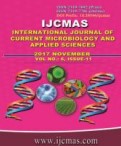


 National Academy of Agricultural Sciences (NAAS)
National Academy of Agricultural Sciences (NAAS)

|
PRINT ISSN : 2319-7692
Online ISSN : 2319-7706 Issues : 12 per year Publisher : Excellent Publishers Email : editorijcmas@gmail.com / submit@ijcmas.com Editor-in-chief: Dr.M.Prakash Index Copernicus ICV 2018: 95.39 NAAS RATING 2020: 5.38 |
Lower respiratory tract Infections (LRTIs) remains the most common infections seen in the community and among hospitalized patients. The increased prevalence of fungal lung infections is largely seen both in immunocompromised and immunocompetent patients. Most of the fungal infections are due to Candida species, especially Candida nonalbicans and among filamentaous fungi, Asperigillus spp is most common, caused by Aspergillus fumigatus, A. flavus, A. niger, A. clavatus, and A. nidulans, followed by other fungal organisms. The aim of the study is to isolate and speciate the different fungal pathogens from bronchial wash specimens from immunocompetent and immunocompromised patients with lower respiratory tract infections by conventional methods. This is a prospective study conducted for a period of 18 months from January 2015 to June 2016 at Institute of Microbiology, Madras Medical College. 488 bronchial wash specimens were collected from patients with lower respiratory tract infections. Age of patients ranged from 12 years to 80 years; 234 were males and 154 were females. Fungal growth was observed in 146 patient samples (29.9%). Yeasts were isolated in 71 samples (48.6%) and filamentous fungi were isolated in 75 samples (51.3%). Diagnosis of deep seated fungi from lower respiratory tract will be more appropriate from Bronchial wash specimens than sputum specimens as the rate of contamination with normal throat commensals is low and isolation of true pathogens is more.Early diagnosis of deep seated fungal infections leads to better control of underlying diseases and results in prolonged survival.
 |
 |
 |
 |
 |